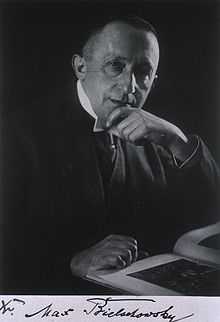Max Bielschowsky

Max Bielschowsky (February 19, 1869 – August 15, 1940) was a Polish neuropathologist born in Breslau.
After receiving his medical doctorate from the University of Munich in 1893, he worked with Ludwig Edinger (1855-1918) at the Senckenberg Pathology Institute in Frankfurt-am-Main. At Senckenberg he learned histological staining techniques from Carl Weigert (1845-1904). From 1896 to 1904 he worked in Emanuel Mendel's (1839-1907) psychiatric laboratory in Berlin. In 1904 he joined Oskar Vogt (1870-1959) at the neurobiological laboratory at the University of Berlin, where he remained until 1933. Later in his career he worked at the psychiatric clinic at the University of Utrecht, and at the Cajal Institute in Madrid.[1]
Bielschowsky made important contributions in his research of tuberous sclerosis, amaurotic idiocy, paralysis agitans, Huntington’s chorea and myotonia congenita. He is remembered for his histopathological work with disseminated sclerosis, the use of an histological silver stain for impregnation of nerve fibers, and with Stanley Cobb, the development of intravital[2] silver staining. The eponymous "Bielschowsky silver stain" technique was an improvement on the method developed by Ramon y Cajal (1852-1934).[1]
Selected written works
- Die Silberimprägnation der Achsencylinder; Neurologisches Zentralblatt, Leipzig, 1902, 21: 579-84. Neurologisches Zentralblatt, Leipzig, 1903, 22: 997-1006; (Bielschowsky stains).
- Allgemeine Histologie und Histopathologie des Nervensystems. In: Max Lewandowsky (publisher), Handbuch der Neurologie. Volume 1, Berlin, 1910.
- Herpes Zoster. In: Max Lewandowsky (publisher): Handbuch der Neurologie. Volume 5, Berlin, 1910.
- Über spätinfantile familiäre amaurotische Idiotie mit Kleinhirnsymptomen. Deutsche Zeitschrift für Nervenheilkunde, 1914, 50: 7-29. (Bielschowsky’s amaurotic idiocy).
See also
References
- ↑ 1.0 1.1 Enersen, Ole Daniel. "Max Bielschowsky". Who Named It. Retrieved 2009-05-31.
- ↑ Cobb, Stanley; Bielschowsky, Max (1925). "A method for intra-vital staining with silver ammonium oxide solution.". Journal für Psychologie und Neurologie 31: 301–304.
|